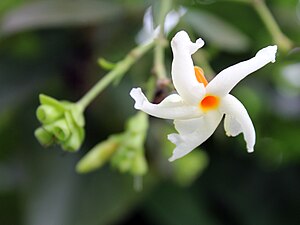Note: This is a project under development. The articles on this wiki are just being initiated and broadly incomplete. You can Help creating new pages.
Nyctanthes arbor-tristis - Parijata
Parijata is a large shrub or small tree with spreading branches. It grows up to 10 metres tall. The plant is particularly valued for its flowers which are used in traditional medicine as a dye and as a source of an essential oil. The plant has very fragrant flowers and is widely cultivated as an ornamental in tropical and subtropical regions all over the world. It is often planted near Hindu temples in India and Sri Lanka, as well as in Malaysia and Indonesia.
Uses
Parts Used
Chemical Composition
Common names
| Language | Common name |
|---|---|
| Kannada | Harisringi, Paarijaatha |
| Hindi | Harshingar, Seoli |
| Malayalam | Manjapumaram, Parijatakam |
| Tamil | Pavazha-malli, Pavilamalligai |
| Telugu | Krishnavaeni, Shvethasurasa |
| Marathi | NA |
| Gujarathi | NA |
| Punjabi | NA |
| Kashmiri | NA |
| Sanskrit | Harasimgara, Kharapatraka |
| English | Coral Jasmine |
Properties
Reference: Dravya - Substance, Rasa - Taste, Guna - Qualities, Veerya - Potency, Vipaka - Post-digesion effect, Karma - Pharmacological activity, Prabhava - Therepeutics.
Dravya
Rasa
Tikta (Bitter)
Guna
Laghu (Light), Rooksha (Dry)
Veerya
Ushna (Hot)
Vipaka
Katu (Pungent)
Karma
Kapha, Vata
Prabhava
Habit
Identification
Leaf
| Kind | Shape | Feature |
|---|---|---|
| Simple | Opposite | Leaves decussate-opposite; petioles 5-20 mm long, not articulate, short-pubescent; Leaf blades ovate or those near the flowers sometimes oblong |
Flower
| Type | Size | Color and composition | Stamen | More information |
|---|---|---|---|---|
| Bisexual | Axillary or terminal panicle | Pale yellow | The flowers are fragrant, with a five- to eight-lobed white corolla with an orange-red centre |
Fruit
| Type | Size | Mass | Appearance | Seeds | More information |
|---|---|---|---|---|---|
| A capsule | 2 cm long and wide, 3-4 mm wide | Compressed | Usually shortly mucronate at the apex, 2-celled, 2-valved, opening transversely from the apex; seeds 1 per cell, compressed | {{{6}}} |
Other features
List of Ayurvedic medicine in which the herb is used
Where to get the saplings
Mode of Propagation
How to plant/cultivate
Coral jasmine is easily propagated by seeds or cuttings [5]
Commonly seen growing in areas
Photo Gallery
References
External Links
- Ayurvedic Herbs known to be helpful to treat Sciatica
- Ayurvedic Herbs known to be helpful to treat Constipation
- Ayurvedic Herbs known to be helpful to treat Intestinal worms
- Ayurvedic Herbs known to be helpful to treat Asthma
- Ayurvedic Herbs known to be helpful to treat Difficulty in micturition
- Ayurvedic Herbs known to be helpful to treat Poisoning
- Herbs with Bark used in medicine
- Herbs with Leaves used in medicine
- Herbs with Heartwood used in medicine
- Herbs with Seeds used in medicine
- Herbs with common name in Kannada
- Herbs with common name in Hindi
- Herbs with common name in Malayalam
- Herbs with common name in Tamil
- Herbs with common name in Telugu
- Herbs with common name in Sanskrit
- Herbs with common name in English
- Habit - Tree
- Index of Plants which can be propagated by Seeds
- Index of Plants which can be propagated by Cuttings
- Herbs that are commonly seen in the region of Tropical area
- Herbs that are commonly seen in the region of Sub tropical area
- Herbs
- Tree
- Ayurvedic herbs that don't have seed photos
- Oleaceae




